FIJI *
* By Mr. Jokatama Toga, Executive Director, Fiji National Council for Disabled Persons, Suva.
A. Need for assistive devices
Fiji is currently unable to collect information on the total number of people with disabilities. Therefore, to specify the number of people who require assistive devices would be speculation.
About 50 to 60 prostheses and 10 orthoses are supplied annually. Unfortunately, information on the number of wheelchairs supplied annually is not available.
Currently, assistive devices are provided from three sources:
- (a) The Prosthetics and Orthotics Laboratory in Tamavua;
-
- (b) The Fiji Red Cross Society, a source of wheelchairs, walkers, and white canes;
-
- (c) The Government Ministry of Health, which supplies equipment for use in hospitals.
These sources are in Suva, a fact which puts rural people with disabilities at a disadvantage.
The needs of disabled persons for assistive device are met through personal funds, sponsorship, or temporary loans of devices from the various government hospitals.
Ninety per cent of the devices used in Fiji are imported. Assistive devices in Fiji are primarily imported from Australia and New Zealand. The types of devices imported include wheelchairs, walkers, walking sticks and daily living equipment. Sixty per cent of these are donated. Charitable organizations can import equipment duty-free, but the 10 per cent value-added tax is still paid on them. It is likely that Fiji will continue to rely heavily on imported devices for the time being, which raises their cost.
B. Policy
At present, Fiji has no explicit government policy on assistive devices. The Fiji National Council for Disabled Persons (FNCDP) has appointed an advisory committee on health, which will consider such a policy. There are no quality-control standards for assistive devices and there is no national standards body.
C. Production capacity
Only two calipers and five prosthetic devices are produced each month in Fiji; these are produced by workshops. With proper facilities and funds, more devices could be produced. However, many people with disabilities cannot afford to pay for the devices.
D. Repair and maintenanceservices
There is currently no repair workshop in Fiji for assistive devices. There are no carpentry or welding workshops capable of providing such services either.
E. Distribution
Assistive devices in Fiji are distributed through the Ministry of Health, and through NGOs. Well-off people with disabilities can buy their own devices. Others apply to the Fiji Red Cross Society whose funds are raised from sponsorship-lottery agencies.
F. Technology
Raw materials indigenous to Fiji include resin, leather, and plaster cement products. Other than these, the materials and components used in producing assistive devices are all imported. They include:
- (a) Polyvinyl acetate (PVA);
- (b) Foams and chemicals;
- (c) Plaster of Paris (POP);
- (d) Materials for braces (rubber);
- (e) SACH feet.
Equipment used in producing devices includes bench saws, stand drills, sanders, leather, plaster cement products and accessories. This equipment is mostly imported from Australia.
Costs of devices are high: (prices in US$)
| Below-knee prostheses | 500 |
| Above-knee prostheses | 965 |
| Braces | 503 |
| Splint (Ankle Foot Orthosis) | 37 |
| Wheelchairs | 370-592 |
G. Personnel
There is only one prosthetic/ orthotic technician in Fiji. This person is employed at an NGO and based at the Tamavua Prosthetics and Orthotics Laboratory. No training is available in Fiji. The FNCDP is presently looking at reviewing this matter in its national plan.
H. Institutional Support
The main source of institutional support for assistive devices is the Fiji Crippled Children Society, an NGO.
I. Technical cooperation
It is clear that training for assistive-device production must be developed in Fiji. However, FNDCP must approach the Government first to discuss questions about technical cooperation.
Caption:
The Fiji Disabled People's Association (FDPA) promotes equal opportunities and a barrier-free environment. Sam Vilsoni, a founder member (above) enjoys using a ramp (introduced through FDPA efforts) in the national museum in Suva
INDIA *
* By Mr. R. Saha, Director, Department of Science and Technology, New Delhi; and Mr. R.S. Kherwa, Chairman-Cum-Managing Director, Artificial Limbs Manufacturing Corpo- ration (ALIMCO), Kanpur.
A. Need for assistive devices
The 1991 national sample survey found over 16 million people with one or the other of four types (visual, hearing, speech and locomotor) of disabilities in India, about 1.9 per cent of the total population. About 80 per cent of them live in the rural areas.
About 2.95 per cent of children under 14 years of age have intellectual disabilities. It is estimated that the total number of people with disabilities would be about 5 per cent of the total population. An estimate by WHO and the Government of India places the number of people with low vision at 28.6 million. There are no exact statistics on how many people with disabilities require assistive devices, but there is a general agreement that 15-20 per cent of the need for assistive devices is being currently met.
Based on the population of disabled persons in India (see Table 1), the requirements for assistive devices of people with various types of disabilities is estimated in Table 2.
Table 1: Extent of Disability
| Type of disability | 1981 | 1991 | ||
|---|---|---|---|---|
| # | per cent | # | per cent | |
| Locomotor | 5427 | 39.68 | 8044 | 49.16 |
| Visual | 3474 | 25.41 | 3626 | 22.16 |
| Hearing | 3019 | 22.08 | 2924 | 17.97 |
| Speech | 1754 | 12.83 | 1768 | 10.81 |
| Total | 13674 | 100.00 | 16362 | 100.00 |
- Notes:
- The estimated number of people with disabilities, excluding people with intellectual disabilities, in all of India, by type of disability, during July-December 1981 and July-December 1991 (the 36th and 47th rounds, respectively, of the National Sample Survey).
- People with multiple disabilities are included in the numbers with both types of disability.
- Hearing and speech disabilities are listed for people 5 years of age and older.
- The percentage of people with multiple disabilities was 14.54 in the 1981 survey and 12.36 in the 1991 survey.
Table 2: Need for Assistive Devices
| Type of device | Estimated number required(million) |
| Prostheses | 0.8 |
| Orthoses | 3.6 |
| Braces | 0.8 |
| Wheelchairs and tricycles | 1.4 |
| Crutches and walking sticks | 1.4 |
| Devices for people with visual impairments | 3.6 |
| Devices for people with hearing impairments | 2.9 |
- Notes:
- The estimates assume one assistive device per disability per user. Multiple devices for users with multiple disabilities are included because of simultaneous/repeat counting of users under the headings for different disabilities. However, possession of duplicate sets of devices by single users cannot be reflected, as that is only countable through a census. The factor has been ignored as it can fluctuate continuously and the number of duplicate sets possessed is likely negligible.
- ALIMCO's average sales-figure ratios are the main basis for these projections.
Table 3: Indigenous Production Capacity
| Device Category | Monthly Estimated |
Production Yearly
Production Capacity |
| Prostheses | 4,600 | 56,000 |
| Orthoses | 21,000 | 252,000 |
| Braces | 4,600 | 56,000 |
| Wheelchairs | 8,200 | 98,000 |
| Crutches, canes, etc. | 8,200 | 98,000 |
There are only a few assistive-device manufacturers in the organized sector in India. Their total production capacity may meet only 5 to 7 per cent of the requirements. No data on manufacturers in informal sector production centres is available, but these centres are probably fulfilling only 2-3 per cent of the requirements of people with disabilities.
Most of the assistive devices in the country are manufactured by indigenous manufacturers in the formal and informal sectors. A few well-off people with disabilities import devices directly from developed countries.
Imports
People with disabilities may import assistive devices for their own use without paying customs duty if they obtain a certificate from a civil surgeon, medical officer, director of health services, or specialist.
Institutions for people with visual or hearing imapirments are permitted to import any equipment that is purchased with donations received in foreign exchange or brought in as a gift item. Overseas agencies from where donations are acceptable from the customs duty angle are listed and similarly the list of the local institutions eligible for duty-free import is also known.
People and institutions do not frequently import devices, as the prices of the imported devices are usually not affordable. In addition, maintenance and repair of such devices is difficult because of non-availability of spare parts or instruction manuals, and at times, incompatible design.
B. Policy
The Government of India has an explicit policy on the development, production and distribution of assistive devices within the country. The policy includes the following:
- A major production facility for indigenous production of artificial limbs has been set up and is supported by the Government of India;
- A scheme of assistance to distribute assistive devices to poor people with disabilities has been in operation for a long time;
- In order to extend the distribution of assistive devices, NGOs are supported by the Government, and more will be supported in the future;
- Training of technical personnel in making assistive devices has been a regular feature of the policy;
- Different government agencies, including the Departments of Science and Technology, Electronics, Rural Development and Education and the Ministry of Labour, along with voluntary agencies and academics, have all been involved in decision-making concerning assistive devices in order to pool available resources;
- All schemes of rural rehabilitation have supply of assistive devices as one of their objectives;
- Research and development in assistive devices is promoted and supported;
- The new policy and legislation concerning persons with disability include all of these as important elements.
The Ministry of Welfare, Government of India, has formulated a national policy on the rehabilitation of people with disabilities.
Standards
Quality-control standards for engineering, medical, scientific, consumer and manufactured items in India are laid down by the Bureau of Indian Standards, controlled by the Government of India. Standards for assistive devices fall under the broad heading of medical and health equipment. The process of laying down standards involves extensive consultation with rehabilitation professionals, scientists, engineers, doctors, manufacturers and people with disabilities.
The standards are not laws; it is not mandatory for producers to follow them. However, those devices which are supplied under government schemes for their provision must have Bureau certification.
In order to ensure that the basic design and production techniques for hearing aids are sound and reliable, for example, the Government has type tested some hearing aids. This procedure includes accelerated testing under extreme environmental conditions of temperature and humidity.
Only devices which pass these tests can be used in government programmes to distribute hearing aids.
Standards exist for many assistive devices, including orthoses and their components, prostheses and their components, wheelchairs, crutches, walking frames, braces, white canes, braille writing frames and slates and hearing aids of different types. At present, there are 60 different standards covering many devices and their components. The Bureau has also set up standards for barrier-free environments, as in the design of ramps and toilets for wheelchair users.
Standards for many more items are not yet set up. In view of new developments in the areas of design, materials, process techniques, computer technology, electronics and the like, it is becoming more important to include performance aspects in the standards and bring the products currently being designed under the umbrella of standards. Awareness among users, rehabilitation institutions and professionals is necessary to ensure that the producers of these devices follow standards laid down by the Bureau.
C. Production
The Artificial Limb Manufacturing Company (ALIMCO) is fully supported by the Government of India's Ministry of Welfare. ALIMCO manufactures a large number of components and finished devices for people with locomotor and visual disabilities, as well as the tools and machines necessary for producing such devices. In the period 1993-94, ALIMCO produced 326,000 lower extremity orthoses, 4,867 upper extremity orthoses, 16,321 lower extremity prostheses, 12,283 upper extremity prostheses and 48,954 other devices for people with locomotor disabilities, including crutches, wheelchairs and tricycles. These figures show a marked improvement over earlier production levels. Due to decreasing availability of wood, lower-limb prosthesis production has fallen in the last few years.
Indian Drugs and Pharmaceuticals Ltd. is the only other company which manufactures components in such large numbers, although its level of production is still lower. Some smaller agencies produce parts, largely for their own use.
Two types of prosthetic feet, SACH and Jaipur, are used in the country.
Wheelchairs and tricycles are produced by ALIMCO, NGOs and private industries. There are at least 15 agencies producing wheelchairs and 20 producing tricycles. Tricycles using motor-scooter (moped) engines are quite common. Tricycles in use weigh between 35 and 50 kg. Wheelchairs of two designs are available: folding and fixed. Bamboo wheelchairs are also in use. These wheelchairs weigh between 25 and 35 kg. Battery-operated wheelchairs are available in the country, but they are heavier and more expensive. A large number of assistive devices, e.g., walkers, crutches and braces, are available off the shelf from places which produce medical equipment, as they are commonly used after fractures, hemiplegia, and similar conditions.
Devices for people with speech and hearing impairments are mainly produced in the private sector. There are as many as 12 agencies which manufacture hearing aids, including group hearing aids. Other devices, like speech trainers, audiometers and flashing lights for telephones, are also produced in India. The most commonly produced are hearing aids. About 20 industries are engaged in the production of hearing aids and other devices.
For people with visual impairments, considerable attention has been paid to enable them to play games and sports. Special types of cricket balls and basketballs have been designed and produced by the National Institute for the Visually Handicapped. A directory of devices available in India for people with visual impairments has been published by the National Association for the Blind. There are about 25 different organizations, including those in the government sector, which are engaged in the production of these devices. The most commonly produced devices are white canes.
Due to a lack of resources, the Government spends only Rs 40-50 (US$1-2) per disabled person per year for assistive devices. As a result, many people with disabilities must obtain devices on their own, and some obtain none at all.
D. Repair and maintenance
Many devices for people with locomotor disabilities can be repaired quite easily. There are many cycle repair shops all over the country. These undertake repairs of wheelchairs and tricycles, although they may have difficulty with certain components, such as castor wheels. Small repairs are also carried out by the centres which provide devices. However, no funds are currently available for repair and maintenance, and many centres find it difficult to meet the cost of repairs. Some policies are under discussion to overcome this difficulty. Electronic devices pose greater problems, as they can only be maintained in a few places.
Repair and maintenance services for assistive devices are as important as making the devices available. All limb-fitting centres (using ALIMCO products), which are located in almost every district in most States of the country, are fully equipped to render these services to persons with disabilities. The necessary spare parts are also available at these centres.
E. Distribution
Multiple approaches to distribution have been adopted, but all with the one aim that everyone who needs an assistive device should get one as soon as possible and at a reasonable price. Assistive devices reach people with disabilities through NGOs, medical colleges and hospitals, national institutions, industry, District Rehabilitation Centres, special schools and camps. Some of these are explained below.
NGOs and government-supported institutions are spread over 19 States and Union Territories. They are financially supported under the Scheme of Assistance to Disabled Persons for Purchase/Fitting of Aids/Appliances run by the Government's Ministry of Welfare, known as the ADIP Scheme. There were 74 such agencies in 1993-94, a 20 per cent increase over 1992-93. The Department of Rural Development has now joined in distribution efforts. Some NGOs not supported by the Government also give out assistive devices.
As many as 25 States and Union Territories among India's 31 States and Union Territories have their own schemes of providing assistive devices through government hospitals and voluntary agencies. Eleven District Rehabilitation Centres provide assistive devices in the rural areas of specified regions.
Orthoses and prostheses generally must be custom made. Trained technicians, prosthetic/orthotic engineers and specialists produce and fit them. There are many limb-fitting centres, 160 of which have been assisted and developed by ALIMCO.
The limb-fitting centres cannot maintain sufficient stock of a complete range of assistive devices. Therefore, the stocks are maintained by dealers who supply limb-fitting centres when the devices are required. There are a good number of such dealers, including 30 dealers appointed by ALIMCO alone.
At present, 81 organizations receive grants directly from the Ministry of Welfare, Government of India, to provide assistive devices to poor people with disabilities.
Many assistive devices, including educational devices, are available through special schools. Devices are also distributed through camps, organized by NGOs and governments. ALIMCO alone organized 92 camps in the year 1993-94. Devices newly developed under government research and development (R&D) programmes are distributed to institutions in order to popularize them.
To obtain a device, potential users approach a centre which has specialists to examine the disability and prescribe a suitable device. Under the ADIP scheme (see Section G), people with disabilities who earn up to Rs. 1200 (US$40) per month get devices free of cost. Those with incomes of Rs. 1201 to Rs. 2500 (US$40 to $80) per month receive devices at a 50 per cent subsidy; those earning over Rs. 2500 (US$80) per month receive devices at full cost. An income certificate is necessary to receive devices at a concessional rate. However, under the District Rehabilitation Centre scheme, an income certificate is not required as the devices are given free of cost to rural people with disabilities.
F. Technology
Almost every type of component is made within India, except for some highly sophisticated electronic or sensory parts. However, wooden, rubber, plastic, leather, fabric, steel, aluminium, brass, forgings, castings, mouldings and welded components are all indigenously manufactured.
All components for orthoses and prostheses are produced in India. Many parts for these devices are available in the open market. The country is self-sufficient in the production of steel and aluminium, the traditionally used metals, and components made from these materials.
Wheelchairs and tricycles use only materials available locally. This results largely from India's massive bicycle industry, which has led to the easy availability of wheels, bicycle chains, tyres and other components. Production is very convenient as mild steel is extensively used, but its use makes these devices very heavy. In addition, the wheelchairs and tricycles are of much larger size than an average Indian. Smaller devices will likely be cheaper as well as more appropriate.
Raw materials available in India are used; few are imported. Local materials include wood, leather, fabric, rubber, plastic, aluminium, brass and steel. The materials used in various categories of assistive devices are shown in Table 4.
Table 4: Materials
| Type of Device | Materials Used |
| Prostheses | Wood, plastic, fabric, rubber, fibre, glass, leather, aluminium, steel |
| Orthoses | Leather, fabric, plastic, aluminium, steel |
| Braces | Leather, fabric, plastic, aluminium, steel |
| Wheelchairs | Steel, rubber, plastic |
| Tricycles | Steel, rubber, plastic, wood, brass, fabric |
| Crutches | Wood, fabric, rubber, aluminium |
| White canes | Aluminium, rubber, plastic |
| Braille slates | Plastic, wood, brass, steel |
| Braille shorthand machines | Aluminium, brass, steel, wood, plastic |
| Ear-moulded hearing aids | Plastic, steel, copper, electric components, battery |
Table 5: Approximate Prices
| Type of Device | Unit Cost (US$) |
| Orthoses (calipers) | 15.0 - 75.0 |
| Prostheses upper | 40.0 - 125.0 |
| Prostheses lower | 70.0 - 125.0 |
| Crutches (per pair) | 18.0 |
| Wheelchairs and Tricycles | 100.0 - 175.0 |
| Braille slate | 5.5 |
| Braille shorthand | |
| machine | 140.0 |
| Cane | 6.0 |
Many polymer materials are indigenously produced; there have been extensive efforts made to use these materials in orthotic devices. The commonly used materials are polypropylene, polyethylene, nylon, PVC and glass-filled polypropylene. PVC tubes are used to make calipers by cutting these open and forming these into designed shapes. Simple moulding techniques are used for fabricating components, e.g., side bars, foot piece and knee piece, from polypropylene. Attempts are being made to adopt injection moulding to produce these in large numbers.
Devices for people with speech and hearing impairments are also made largely from indigenous materials and components. Imported components include receivers, switches for controls in hearing aids, bone vibrators and some integrated circuits. The devices are inexpensive relative to global prices.
Similarly, most devices for people with visual impairments are produced by using materials and components available inside the country. All the components used in braille typewriters and braille shorthand machines, such as levers for keys and sliding mechanisms, are manufactured locally. Considerable efforts have gone into developing a slightly higher level of technology. In order to cut down development time and cost, some subsystems, such as speech chips and zoom lenses, have been imported during development and production.
Dies are made for many products, including prosthetic feet, knee joints, and braille writing frames. The production techniques used are commonly known ones such as forging, injection moulding, casting and vacuum forming. Machines for these techniques are easily available. The cost of die-making in Indian companies is quite competitive with that in other countries.
Most of the machines and equipment used in the production of assistive devices are powered by electric motor hydraulic and pnuematic power. The types of machines and equipment currently used are listed in Table 6.
Table 6: Sample Types of Machines and Equipment
| Type of Machine | Detailed Categories |
| Turning machine turning lathes and autotraubs |
Centre lathes, capstan and turret lathes, copy |
|
Milling machines |
Horizontals, vertical, copy milling (bridgeport) and universal types |
| Grinding machines | Surface grinders, cyclindrical grinders, tool cutters and centreless grinders, deburring and pedestal grinders |
|
Drill machines |
Bench drills, pillar drills, gang drills, radial drills |
| Metal presses | Mechanical, electro-pneumatic hydraulic presses and metal shearing presses |
| Pipe-bending machine | Semi-automatic pipe benders |
| Welding machines | Electric arc welding, gas welding, mig welding, and spot welding machines |
| Woodworking machines | Saw mills, planing machines, wood turning lathes, copy turning machines, wood carving machines |
| Forging and foundry | Heating and melting furnaces, machines, pneumatic hammers |
| Painting and plating | Nickel chromium painting gun, booth, powder equipment, painting equipment, baking furnaces, plating tanks, pre-treatment equipment |
| Special-purpose machines | Jig boring machines, electric discharge machines |
G. Institutional support
The Government of India's Scheme of Assistance to Disabled Persons for Purchase/Fitting of Aids/Appliances (ADIP Scheme) aims to assist poor people with disabilities in obtaining sophisticated, and durable, modern "standard" aids and appliances.
People are eligible for assistance under the ADIP scheme if they meet the following criteria:
- (a) Indian citizens of any age and either sex;
-
- (b) Certified as disabled by a registered medical practioner;
-
- (c) Monthly income from all sources (or monthly income of parents and guardians, in the case of dependents) does not exceed Rs 2500 (US$80).
People can receive assistance for the same device every two years. Children under 12 years of age can receive assistance every year.
Only those devices costing between Rs 25 (US$ 0.80) and Rs 3600 (US$ 120) are covered under the Scheme. These limits apply to each device separately. The Scheme provides for fitting charges up to Rs 25 and travel assistance up to Rs 150 (US$ 5) per beneficiary, along with coverage of board and lodging expenses up to Rs 10 (US$ 0.33) per day for people whose income is no more than Rs 1200/ per month.
Almost a decade has elapsed since the Scheme was started. Many new devices have been developed in India since then. Some of these devices may cost more than Rs 3600/. Some other provisions of the Scheme show some incompatibility with the present socio-economic situation. The Scheme is being considered for revision.
Many State governments and Union Territories have their own schemes of providing aids/appliances to poor people with disabilities. These largely cover locomotor disabilities. In addition, some international NGOs donate assistive devices to institutions which distribute them.
H. Personnel
India has a well-developed system of training technical personnel at various levels for aquiring different levels of skills. Engineering colleges, polytechnics and Industrial Training Institutes (ITI) all impart different levels of skills. At the least advanced end, there are about 2100 ITIs, which admit those who have completed ten years of schooling. Students are trained in engineering trades such as machining, fitting, carpentry and welding. At the intermediate level, there are 530 polytechnics, which include 62 polytechnics for women. Entry to these is after 12 years of schooling. The most advanced are the 288 engineering colleges and Indian Institutes of Technology, which offer four-year engineering degrees after 12 years of schooling. Unfortunately, not many professionals trained in this system have entered the area of rehabilitation and assistive devices, although this situation is slowly changing.
In the specific area of orthotic and prosthetic engineering, seven institutes offer certificate, diploma or degree courses. These are the National Institute of Orthopaedically Handicapped, Calcutta; National Institute for Rehabilitation Training and Research, Cuttack; Institute of Physically Handicapped, New Delhi; All-India Institute of Physical Medicine and Rehabilitation, Bombay; Government Institute for Physical Medicine, Madras; Safdarjung Hospital, New Delhi; and Schieffelin Leprosy Research and Training Centre, Karigiri. All these courses are recognized and accredited by the Rehabilitation Council of India, a statutory body under the Ministry of Welfare. The duration of the diploma offered is two-and-a-half years and of the degree, three-and-a-half years. Degree courses are only available at Calcutta and Bombay. The entrance qualification is 12 years of schooling. About 100 orthotic and prosthetic engineers graduate every year. They are trained in basic skills of fabricating assistive devices, with exposure to basic medical, scientific and engineering principles. They are usually employed in government, government-supported agencies and NGOs.
I. Technical Cooperation
India will extend its full support to any technical exchange programme, developed on mutually agreed terms, which would benefit people with disabilities in developing countries of the ESCAP region. The areas of participation could be joint R&D projects and subsequent technology transfer, common field trials of devices, joint production ventures, pooling of requirements of countries for harnessing economies of scale and the exchange of technical and managerial skills.
J. Research and development
The research and development of assistive devices has been a relatively recent phenomenon. The Government of India launched the Science and Technology Project in Mission Mode for the Welfare and Rehabilitation of Handicapped in November 1988 through the Ministry of Welfare. The concept of the project is to ensure that those new interdisciplinary efforts in science and technology which could meet the country's large-scale needs fulfil this potential quickly. The emphasis is on an end-to-end approach covering R&D as well as technological, financial, administrative and management aspects. The thrust is on concentrating on new scientific inputs, generation of new technologies and guiding these to large scale use. The objective is to coordinate, fund and direct application of technology in the development and use of suitable, cost-effective aids and appliances, and of methods of education and skill development.
Until the project, technology efforts were characterized by sporadicity, poor coordination, weak links with users, lack of funds and focus on locomotor disability. These shortcomings were dealt with in this project by incorporating it in five-year plans, involving many government agencies and NGOs in planning, decision-making and execution, setting up strong linkages and covering all areas of disability.
More effort is required in research, development and product improvement through acquiring the latest technology. Computer-aided design (CAD) technology may be taken up as an R&D activity so that it can improve delivery services to people with disabilities. Standardization of assistive devices is useful for universal designs and interchangeability. Polypropylene material is useful in manufacturing prostheses because of its superior strength, compactness and low cost.
The project is managed at four different levels covering the formulation of specific R&D projects, their evaluation, sanction of funds and continuous monitoring.
There are four Technical Advisory Groups, one for each category: people with orthopaedic (including cerebral palsy and leprosy-cured), visual, hearing (or speech), and mental disabilities. These Groups are required to meet every three months. Their members include concerned government departments, academic and research institutions, and doctors, engineers and professionals from NGOs. These groups identify new areas for reseach, evaluate R&D proposals and help in monitoring progress. A quarterly review of the on-going projects is undertaken.
An apex-level committee chaired by the Secretary, Ministry of Welfare, provides direction and guidance and approves projects recommended by the Technical Advisory Groups for funding. Its members are the Secretaries of the Department of Science and Technology, Department of Electronics, Planning Commission, Ministry of Health, Director General, and Indian Council of Medical Research, and an NGO representative. The Committee is required to meet every three months.
A semi-annual review is taken by a nominee of the Prime Minister's Office. Initially this nominee was the Scientific Advisor to the Prime Minister, then the Minister of State for Science and Technology, and now it is the Secretary, Science and Technology.
Full funding is provided to agencies for R&D project staff, equipment, consumables, travel, contingencies, and other purposes. Funding of NGOs ensures that they have full technical back-up through formal association with a technical institution. Public sector undertakings are required to share the cost of the project.
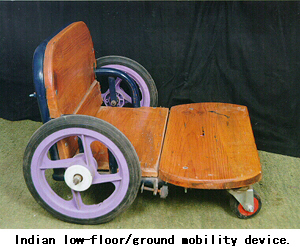
Selection of areas for research is an important step. Selection is based on the following criteria:
- (a) Constant interaction with users, service providers and peer groups;
- (b) Brainstorming sessions with experts;
- (c) Locating laboratory-level technologies;
- (d) Evaluation of existing devices;
- (e) Study of journals, books and other academic materials;
- (f) Expertise available.
Research and development projects are also awarded by other agencies, including the Department of Science and Technology (DST), Department of Electronics, Department of Education and some NGOs. The DST's projects have been emerging from its programme for developing new, advanced materials. After a DST-funded project to develop a Floor-Reaction Orthosis (FRO) with polymeric materials for children with polio, a joint project was funded at the Composite Product Centre under the Defence Research and Development Organization for evolving production methods for polymeric rehabilitation aids. The funding was provided by the DST and the Ministry of Welfare.
Modular orthoses are being developed in India for children with polio. Through extensive measurements of the bodies of children with polio, in special camps for this purpose, some standard sizes for modular orthosis components have been generated by computer simulation. These pieces can be assembled by most limb-fitting centres in India with the help of a heat gun to weld the pieces together.
INDONESIA *
* By Mr. Ramelan, Technician, National Rehabilitation Centre, Social Department, Solo; Ms. Heny Soelistyowati, Field coordinator CBR, Development and Training Centre, Solo; and Mr. Suharyono, Staff, Pusat Rehabilitasi, YAKKUM, Yogyakarta.
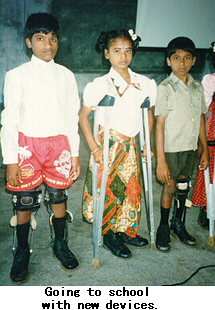
A. Need for assistive devices
Indonesia has about 5,772,400 people with disabilities, i.e., about 3.11 per cent of the country's total population. The distribution in terms of various categories of disabilities is given below:
-
Locomotor 27.3% = 1,575,865 Visual 28.9% = 1,668,230 Mental 12.8% = 738,865 Hearing 10.0% = 577,240 Other (e.g., leprosy) 21.0% = 1,212,200
To help poor people with disabilities, the Indonesian Government's Ministry of Social Affairs has mobile rehabilitation units which provide prosthetic and orthotic devices.
B. Production
The National Rehabilitation Centre for the Physically Handicapped (NRC) makes prosthetic and orthotic devices at low cost. See Table 1 for the prices for fabrication and repair in 1993 and 1994 at the NRC Prosthetic and Orthotic Workshop. The Prof. Dr. Soeharso NRC workshop in Surakarta is intended for fabrication and repair of artificial limbs. Table 2 describes its targets for the fiscal year 1993/1994.
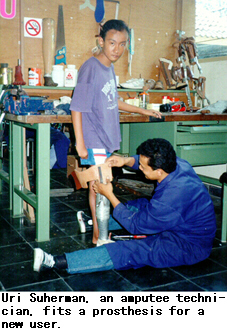
Based on the data from the Department of Social Affairs and Department of Health (1994), the units of production that have the capability of supporting production capacity are:
- Prof. Dr. Soeharso Hospital of Orthotics and Prosthetics, Solo (Java);
- Prof. Dr. Soeharso Rehabilitation Centre, Solo (Java);
- Indonesian Institution for the Care of Disabled Children, Solo (Java);
- YAKKUM Rehabilitation Centre, Yogyakarta, (Java);
- Unit of Medical Rehabilitation, Dr. Sutomo General Hospital, Surabaya (Java);
- Unit of Medical Rehabilitation, Navy Hospital, Surabaya (Java);
- Unit of Medical Rehabilitation, Dr. Kariyadi General Hospital, Semarang (Java);
- Unit of Medical Rehabilitation, General Hospital, Dr. Sardjito, Yogyakarta (Java);
- Unit of Medical Rehabilitation, Army Hospital, (Java);
- Dr. Ciptomangunkusumo Hospital, Jakarta, (Java);
- Fatmawati Hospital, Jakarta, (Java);
- Hasan Sadikan General Hospital, Jakarta (Java);
- General Hospital, Palembang (Sumatra);
- General Hospital, Ujung Pandang (Sulawesi).
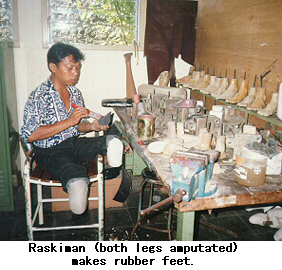
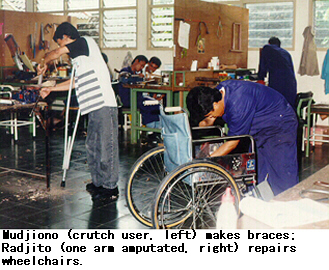
C. Repair and maintenance
D. Distribution
The list of producers in Section B demonstrates that most units of production are on Java island. However, the provincial general hospital in each of Indonesia's 27 provinces has the capacity to provide assistive devices. The general hospital in each district or sub-district can refer people to the provincial hospital or other producers of assistive devices.
E. Personnel
The Ministry of Social Affairs, in cooperation with the United Nations Development Programme (UNDP), held training courses for prosthetic and orthotic technicians five times since 1982.
About 100 prosthetic and orthotic technicians work in Indonesia. Most have been trained for six months. They come from technical schools in several subjects. A professional came from Jaipur, India, to train technicians in Indonesia. The curriculum of the training program was:
- Introduction to the approach and philosophy behind the Jaipur Foot technology.
- Practical demonstration of the fabrication and fitting of a below-knee prosthesis.
- Arranging fabrication and re-shaping of tools according to the user's requirement.
- Die-making and taking a plaster mould of a foot.
- Making suspension, inside padding, and outside finish for below-knee and above-knee protheses.
- Making below-knee prostheses, measurement, cutting and fabrication of the socket.
- Fabrication of the Jaipur Foot.
- Assigning patients to individual workers for independent work.
- Solving problems of individual workers.
Table 1: Device Fabrication Prices at the NRC Workshop
| Item Description | Price(US$) |
|
Below-knee prosthesis |
35.00 |
| Above-knee prosthesis | 45.00 |
| Below-elbow cosmetic prosthesis | 35.00 |
| Above-elbow cosmetic prosthesis | 40.00 |
| Brace | 35.00 |
| Wheelchair | 75.00 |
| Corset | 45.00 |
|
Canadian crutch |
12.00 |
| Wooden crutch | 10.00 |
| Orthopaedic shoes | 12.00 |
| Jaipur Foot | 10.00 |
Table 2: Targets of the Prof. Dr. Soeharso Workshop
| Type of device | Target |
| Prostheses and orthoses | 42 pieces |
| Brace | 59 pieces |
| Orthopaedic shoes | 11 pieces |
| Wheelchairs | 15 pieces |
| Crutches | 65 pairs |
| Canadian crutches | 84 pairs |
| Shoes | 44 pairs |
| Repair of any devices | 145 times |
Table 3: Users Obtaining Prostheses and Orthoses in 1993 and 1994
| Month | Users | Number of Prostheses | Number of Orthoses |
| April 1993 | 21 | 2 | 43 |
| May | 17 | 3 | 35 |
| June | 15 | - | 35 |
| July | 18 | 4 | 37 |
| August | 40 | 2 | 61 |
| September | 26 | 9 | 17 |
| October | 22 | 4 | 34 |
| November | 19 | 2 | 38 |
| December | 9 | - | 27 |
| January 1994 | 7 | - | 11 |
| February | 13 | 2 | 12 |
| March | 6 | 3 | 3 |
| Total | 213 | 30 | 353 |
Table 4: People with locomotor disabilities who obtained devices in 1993/1994
| Type of device | Rest | 1993/1994 | Total | Finished | Not yet finished |
| Above-knee prosthesis | 4 | 8 | 12 | 5 | 7 |
| Joint-knee prosthesis | - | 3 | 3 | 3 | - |
| Below-knee prosthesis | 4 | 10 | 14 | 11 | 3 |
| Above-elbow prosthesis | 3 | 5 | 8 | 4 | 4 |
| Joint-elbow prosthesis | - | - | - | - | - |
| Below-elbow prosthesis | 3 | 4 | 7 | 3 | 4 |
| Brace | 31 | 59 | 90 | 59 | 31 |
| Orthopaedic shoe | 17 | 24 | 59 | 50 | 9 |
| Orthopaedic tool | 92 | 248 | 340 | 330 | 10 |
| Wheelchair | - | 6 | 6 | 3 | 3 |
| Total | 154 | 385 | 539 | 468 | 71 |
Table 5: Tools for Prostheses and Orthoses in 1993-94
| Rest | No. of Tools | Finished | Not yet finished | |
| Above-knee prosthesis | 4 | 12 | 5 | 7 |
| Joint-knee prosthesis | - | 3 | 3 | - |
| Below-knee prosthesis | 4 | 14 | 11 | 3 |
| Above-elbow prosthesis | 3 | 8 | 4 | 4 |
| Joint-elbow prosthesis | - | - | - | - |
| Below-elbow prosthesis | 3 | 7 | 3 | 4 |
| Brace | 31 | 90 | 59 | 31 |
| Orthopaedic shoe | 17 | 59 | 50 | 9 |
| Other orthopaedics | 92 | 340 | 330 | 10 |
| Wheelchair | - | 6 | 6 | 3 |
| Total | 154 | 539 | 468 | 71 |
Table 6: Prosthesis and orthosis repair in 1993/1994
| Rest | 1993/1994 | Total | Finished | Not yet finished | |
| Above-knee prosthesis | - | 8 | 8 | 8 | - |
| Joint-knee prosthesis | - | - | - | - | - |
| Below-knee prosthesis | 4 | 8 | 12 | 12 | - |
| Above-elbow prosthesis | 1 | 1 | 2 | 2 | - |
| Joint-elbow prosthesis | - | - | - | - | - |
| Below-elbow prosthesis | - | 2 | 2 | 2 | - |
| Brace | 32 | 21 | 53 | 53 | - |
| Orthopaedic shoe | - | 5 | 5 | 5 | - |
| Orthopaedics tool | 12 | 6 | 18 | 18 | - |
| Wheelchair | 18 | 109 | 127 | 123 | 4 |
| Total | 67 | 160 | 227 | 223 | 4 |
Table 7: Number of Devices Distributed through the Mobile Rehabilitation Unit in Central Java
| Type of device | 1990/1991 | 1991/1992 | 1992/1993 | 1993/1994 |
| Wheelchair | 53 | 66 | 45 | 46 |
| Wood crutch | 129 | 100 | 87 | 72 |
| Canadian crutch | 56 | 50 | 28 | 48 |
| Tripe | 14 | 20 | 6 | 24 |
| Black glasses | 16 | - | 26 | 36 |
| Hearing aid | 12 | 20 | 16 | 12 |
| White cane | 236 | 400 | 220 | 180 |
| Brailler | - | 60 | 24 | 36 |
| Book for deaf people | 209 | 300 | - | 480 |
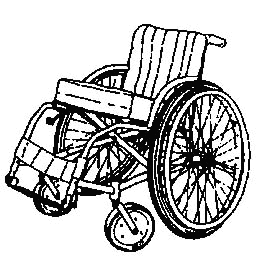
"Merdeka" wheelchair made by the R.S. Fatmawati Hospital, Jakarta
- Made of steel
- Brake that can lock strongly
- Position of footrest which can be adjusted
- Made to order
- Made of materials which are easy to find in the market
- Seat to prevent pressure sores available
- Selection of colour according to choice available
- Push break made of coated steel (chromed)
- Adjustable back wheels
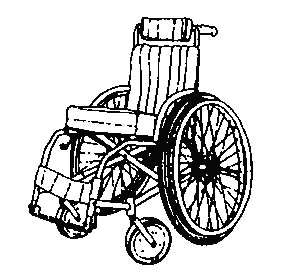
Extra supplement available under order
- Head rest
- Additional back rest to make it higher
- Chrome (coating)
- Adjustable back rest which can be adjusted for sleeping
- Extra holders to avoid being rolled over backward
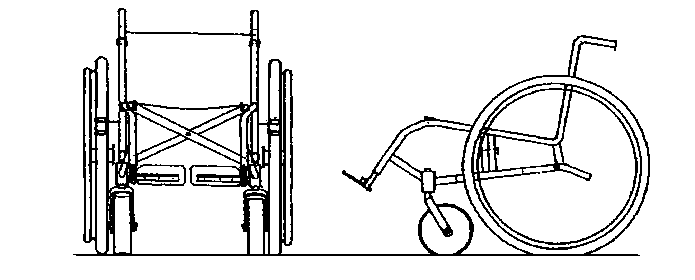
"Merdeka" wheelchair specification
| Folding | Fixed | Rural | Sport | |
| Weight | 17 kg | 16 kg | 15 kg | 13 kg |
| Camber | 0o 3o | 3o | 15o | - |
| Back wheel | 24 kg | 24 kg | 26 kg | 24 kg |
| Front wheel | O7 kg | O7 kg | O7 kg | O7 kg |
| Small | Medium | Large | |
| Length seat | 34 cm | 37 cm | 40 cm |
| Width seat | 33 cm | 36 cm | 40 cm |
| Minimum | Maximum | Choice | |
| Distance between footrest and seat | 30 cm | 45 cm | Adjustable |
| Height of (foot or head) rest | 25 cm | 35 cm | Can be ordered |
Background
- The Merdeka wheelchairs were introduced in R.S. Fatmawati Hospital by the English-based charity MOTIVATION. Motivation specializes in designing wheelchairs for developing countries and has set up workshops in Afghanistan, Bangladesh, Cambodia, Poland and the Russian Federation.
- Initially a research study was conducted to establish the needs of the disabled community, availability of equipment and local materials, skill levels of local labour, site assessment and distribution systems. A business plan was drafted, including pricing the chairs, which are priced on a non-profit making basis. The Merdeka chair can be produced at a fraction of the cost of a comparable chair in a developed country and is made to suit each individual user.
Aim
- To design a wheelchair in association with disabled individuals and rehabilitation professionals and utilising locally available materials for both adults and children.
- Establish a production unit at R.S. Fatmawati, wherever possible encouraging the recruitment of people with disabilities.
- Identify and commence a distribution system.
- Create a "Wheelchair Fund" to assist in financing those who cannot afford to buy their own chair.
Design
- Using locally available materials and local manufacturing methods, the chair was designed around the following specifications:
- will fold to fit into the trunk of a standard saloon car.
- is adjustable to accommodate both children as well as adults.
- can be customized to suit individual user needs.
- will meet the challenges of the local environment.
- looks good and will enhance user self-esteem.
- requires low maintenance and can be repaired in a bicycle shop.
Distribution
- Distribution is mainly to the patients at R.S. Fatmawati Hospital, which is the main spinal injury hospital in Jakarta. The Hospital has distribution agents working in Solo and Surabaya and it is hoped to establish more in the near future. The main difficulty is in communication, as the people to be helped are in the outlying areas. This has been discussed with the Department of Health; through a regional health service team who regularly visits kampungs, Fatmawati Hospital hopes to help more people in need.
Wheelchair fund
- This fund was established specifically to help people who cannot afford the full price of a chair which currently is Rp.325,000. To apply for funding assistance, a minimum of 10 per cent must be put towards the cost of buying the chair and letters supporting inability to pay the balance must be produced from the local head of the village.
- This fund is constantly in need of further resources and Fatmawati Hospital is encouraged by support from the expatriate charity organizations and also by international companies which have been very supportive.
Sport
- In May 1994, with the assistance of two student volunteers from Jakarta International School, weekly basketball, tennis and swimming began. There was much enthusiasm and the tennis players suggested they form a league, in which Kusnan, the Distribution officer is involved. This led to a tennis chair being developed in the workshop. The tennis chair has been a great success and has had the support of the International World Tennis Federation (IWTF) which has sponsored the delivery of chairs to India, Philippines, and Sri Lanka, Kusnan has travelled to Japan and Malaysia teaching other disabled people wheelchair skills.
Production
- The workshop is staffed by 9 workers, half of whom are disabled. In 1996 they produced 187 chairs, which is still short of the target 20 per month. Twenty per month is the production capacity required to generate sufficient monies to support the wages and supplies for the next months' production. The Board of Trustees is working towards this goal and hopes that by the end of 1997, production will have increased to 200.
Source: Dr. Gerry Heryati, Fatmawati Hospital and Mr. Tomas Lagerwall, ICTA.
MALDIVES *
* By Ms. Aishath Mahfooza Hassan, Member, Maldivian Association of the Handicapped, Male.
A. Need for assistive devices
No formal survey on disability has yet been completed, so no statistics are available. It is therefore difficult to estimate whether the majority of those who need devices receive them.
People requiring assistive devices are checked by rehabilitation specialists to identify the devices necessary. These devices are then procured by the Ministry of Health and Welfare. Private parties also contribute in the process.
Ninety-nine per cent of the assistive devices used in the Maldives are imported. There are no specialized centres for local production of assistive devices. The main sources of import are China, India, Japan and Singapore. The devices most commonly imported are wheelchairs, tricycles, crutches, walkers and hearing aids. Those requiring artificial limbs, calipers and braces are sent to India or Colombo, Sri Lanka, for fitting. Of devices that are imported, 90 per cent are purchased by the Ministry of Health and Welfare; the other 10 per cent come from private donations. There is currently no duty exemption on these imports.
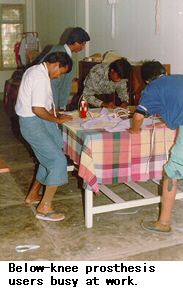
B. Policy
There is no explicit government policy or programme to support the production of assistive devices.
C. Repair and maintenance
Repair and maintenance work is mainly carried out at carpentry centres and small workshops intended for the repair of bicycles and other vehicles. Some people with disabilities undertake such repair jobs.
D. Distribution
Those requiring assistive devices can directly contact the Ministry, and it will provide for their needs directly.
E. Personnel
A short-term course was arranged by India's ALIMCO to provide training in orthotics and prosthetics. The trainees, however, do not engage in the production of these devices.
F. Technical cooperation
The Maldives has little or no technical assistance to contribute to a TCDC programme, but would be interested in participating as a beneficiary of training of personnel for indigenous, small-scale production of assistive devices.
Go back to the Contents
ECONOMIC AND SOCIAL COMMISSION FOR ASIA AND THE PACIFIC
Production and distribution of assistive devices for people with disabilities: Part 2
- Chapter 5 to 8 -
ST/ESCAP/1774
UNITED NATIONS PUBLICATION
Sales No. E.98.II.F.7
Copyright c United Nations 1997
ISBN: 92-1-119775-9
